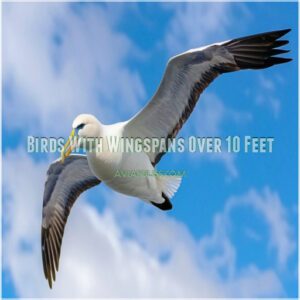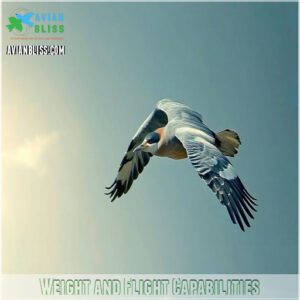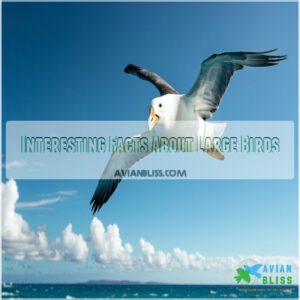This site is supported by our readers. We may earn a commission, at no cost to you, if you purchase through links.
 You’ll find the world’s most impressive birds with largest wingspan soaring high above the oceans and mountains.
You’ll find the world’s most impressive birds with largest wingspan soaring high above the oceans and mountains.
The Wandering Albatross leads the pack with wings stretching up to 12 feet – that’s wider than your car! Following close behind are the Great White Pelican at 11.8 feet and the majestic Andean Condor at 10.5 feet.
These aerial giants use their massive wings for efficient gliding, some covering over 120,000 kilometers yearly without landing.
Their remarkable adaptations, from hollow bones to specialized feathers, make them true masters of the sky.
But there’s a fascinating twist to how these birds achieve such extraordinary flight capabilities, with their ability to cover vast distances making them a wonder of nature.
Table Of Contents
- Key Takeaways
- Birds With The Largest Wingspans
- Largest Flying Birds by Wingspan
- What is Wingspan
- Largest Birds by Weight
- Threats to Large-Wingspan Birds
- Flight Characteristics of Large Birds
- Mating Behaviors of Large Birds
- Diet and Foraging Habits
- Conservation Status of Large Birds
- Interesting Facts About Large Birds
- Frequently Asked Questions (FAQs)
- Which bird has the largest wingspan?
- Which is the largest bird in the world?
- Which seabird has the largest wingspan?
- What is the biggest bird in the world?
- What species of birds have the largest wingspan?
- How big is the wingspan of the wandering albatross?
- What is the bird with the largest wingspan?
- What bird has a 24 foot wingspan?
- Is a condor bigger than an albatross?
- What bird is bigger than a bald eagle?
- Conclusion
Key Takeaways
- You’ll find the Wandering Albatross leads all birds with a 12-foot wingspan, followed by the Great White Pelican at 11.8 feet and the Andean Condor at 10.5 feet.
- These giant birds can travel over 120,000 kilometers yearly without landing, using their hollow bones and specialized feathers to glide effortlessly on ocean winds and mountain thermals.
- While they’re masters of flight, large-winged birds face serious threats from habitat loss, fishing gear entanglement, and climate change that disrupt their breeding grounds and migration patterns.
- You’ll see these birds demonstrate remarkable monogamy and mating rituals, with pairs returning to the same breeding colonies year after year and performing elaborate courtship displays.
Birds With The Largest Wingspans
You can’t talk about massive wingspans without bringing up birds like the Wandering Albatross, whose wings stretch up to 12 feet.
These airborne giants have adapted their impressive wings to glide with minimal effort, whether over oceans or mountain ranges, showcasing their ability to glide.
Wandering Albatross Characteristics
Meet the Wandering Albatross, a master of the skies with the largest wingspan at 3.2 meters.
These magnificent giants dominate the Southern Ocean, showcasing unparalleled flight patterns. Their life’s a tale of endless bird migration, covering 120,000 km annually.
Here’s why they’re legends:
- Wingspan: Record-breaking at 12 feet.
- Habitat: Southern Oceans.
- Flight: Sustained glider.
- Diet: Marine life.
- Adaptation: Energy-efficient flight.
Andean Condor Features
In the thin air of the Andes, the Andean Condor commands the skies with ease, boasting the largest bird wingspan in South America.
- Wingspan: Stretches up to 10.5 feet wide, breaking bird wingspan records.
- Flight Patterns: Glides effortlessly for hours, conserving energy.
- Habitat: Nests along cliff edges, using its sharp beak for scavenging.
Great White Pelican Size
The Great White Pelican, a true marvel among the largest flying birds, boasts an impressive 3.6-meter bird wingspan record.
Its white feathers and unique beak shape help it expertly hunt fish across open waters.
Known for graceful flight patterns, these majestic creatures glide effortlessly, nesting near lakes and wetlands.
Truly, the Pelican’s size symbolizes nature’s engineering at its finest.
Largest Flying Birds by Wingspan
You’re about to meet the true titans of the skies, boasting wingspans so vast they seem to defy gravity.
From the Wandering Albatross to the Andean Condor, these birds rely on incredible wingspan adaptations to glide effortlessly over oceans and mountains.
Top 10 Largest Birds
The largest flying birds showcase nature’s ingenuity with record-breaking Bird Sizes and Wing Shapes.
The wandering albatross claims the crown, boasting the planet’s largest wingspan at 12.1 feet. Others, like the Andean condor or great white pelican, show off massive wings built for soaring over mountains and seas.
These biggest birds alive are aerodynamic wonders, traveling vast distances and reflecting the diversity of bird species among the largest wingspan birds today.
The sizes of these birds can be found in the largest flying birds category, highlighting their unique characteristics.
Birds With Wingspans Over 10 Feet
Birds with wingspans over 10 feet are like nature’s gliders, effortlessly conquering the skies.
These flying marvels demonstrate incredible adaptations that make them standout members of the avian world.
Here’s a quick look at five impressive species:
- Wandering Albatross: Holds the record, boasting an awe-inspiring 12-foot wingspan.
- Andean Condor: Known for its elegant gliding over cliffs, reaching 11 feet.
- Great White Pelican: Nearly 11.8 feet, a cooperative hunter.
- Dalmatian Pelican: Reaching 11.5 feet, actively soaring.
- Southern Royal Albatross: Graceful with an 11.5-foot span.
Variation in Wingspans Across Species
Have you ever wondered why wing size varies so much among birds? It’s all about survival.
The wingspan of birds adapts to their environment, helping them thrive. The wandering albatross, with the largest wingspan, glides across oceans effortlessly, while the Andean condor masters soaring over cliffs.
Wing shape and aerodynamic effects play key roles in flight patterns. Meanwhile, species comparison reveals smaller-winged birds, like puffins, rely on flapping power.
Each wingspan tells an amazing story of evolution and efficiency.
What is Wingspan
Wingspan is the distance from the tip of one wing to the tip of the other when a bird spreads both wings fully.
It helps you understand how birds like the wandering albatross glide effortlessly across vast oceans, almost as if they’re showing off nature’s engineering.
Definition and Significance
Wingspan, the breathtaking measure from wingtip to wingtip, showcases a bird’s grace and flight design.
It’s more than length—it defines Flight Mechanics and Aerodynamic Principles.
- Wingspan Measurement aids bird classification.
- Links size to survival in the wild.
- Helps compare the world’s largest bird species.
- Sheds light on bird species facing extinction.
Adaptation to Environment
Regarding wing structure, birds with the largest wingspan exhibit remarkable adaptive traits influenced by various environmental pressures.
For instance, albatrosses utilize ocean winds for prolonged gliding, while Andean condors ascend effortlessly on mountain thermals.
This evolution in bird wingspans illustrates how habitat diversity refines flight patterns. Each wing’s shape isn’t merely aesthetic—it’s a precise instrument for survival.
These unique bird adaptations guarantee they traverse their environment with unparalleled grace, efficiency, and purpose. Comprehending bird adaptations is essential for understanding the intricate connections between birds and their habitats.
Importance in Bird Research
Figuring out a bird’s wingspan lets researchers discover secrets about bird migration, flight patterns, and wildlife monitoring.
When comparing wingspan sizes, you’ll see how albatrosses conquer oceans while condors soar effortlessly over mountains.
It’s not just numbers on a chart; wingspan evolution highlights survival strategies and adaptations tied to species conservation.
From gliding on thermal currents to mastering long flights, birds with the largest wingspan spark discoveries about their habitats, behaviors, and future.
Who knew measuring wings could inspire both science and awe?
Largest Birds by Weight
You might think birds with massive wingspans are lightweight fliers, but some of the heaviest are true powerhouses.
From the hefty Kori Bustard to the Andean Condor, their sheer weight challenges what you’d expect from creatures that can still take to the skies.
Heavy Flying Birds
When you think about the largest flying birds, the Kori Bustard and Dalmatian Pelican easily come to mind.
These heavy fliers, tipping scales above 15 kg, carry remarkable bulk while defying gravity. Thanks to aerodynamic wings balancing weight limits, they soar seamlessly through the skies.
Evolution crafted their bird anatomy to handle challenging flight patterns and migration demands. Carrying the largest bird wingspan is nature’s engineering feat—one that lets these giants cross landscapes effortlessly.
Who knew that being grounded wouldn’t stop them from taking remarkable flight, and with such heavy bulk they still manage to defy expectations?
Weight and Flight Capabilities
For large birds, weight’s like carrying a backpack during a hike—it shapes how they fly. Efficient wing load is critical for lift, balancing aerodynamics with power.
- Flight Efficiency: Heavier birds rely on perfect aerodynamic lift.
- Gliding Techniques: Their larger wingspans reduce effort mid-air.
- Energy Balance: Flapping’s tiring, but the wingspan-to-body size ratio helps conserve energy.
Understanding the biggest birds species characteristics is essential to grasping these concepts.
Weight Distribution Across Species
Bird species with the largest wingspan exhibit fascinating weight distribution strategies to balance Body Mass and flight efficiency.
A heavy frame doesn’t mean clumsy—think of the Kori Bustard, a true heavyweight champion.
Here’s how some species compare:
| Bird | Body Mass (kg) | Wingspan (m) |
|---|---|---|
| Kori Bustard | 18 | 2.47 |
| Andean Condor | 15 | 3.3 |
| Wandering Albatross | 12 | 3.7 |
Mass Distribution lets these giants glide gracefully, trading agility for endurance.
Threats to Large-Wingspan Birds
You might think that birds with giant wingspans have it all figured out, but they face some serious challenges.
From habitat destruction to getting caught in fishing gear, these majestic fliers encounter threats that require urgent attention.
Habitat Loss and Climate Change
Large-winged birds, like those boasting the largest wingspan, are grounded by climate shift and habitat destruction.
As seas rise and forests fade, their migration paths crumble. Nesting sites vanish, causing ecosystem disruptions.
These birds, with a notable example being the largest flying birds, face significant threats to their survival.
- Practice habitat conservation, such as replanting trees near wildlife migration corridors.
- Support bird conservation programs tackling environmental degradation.
- Push for sustainable policies addressing climate change and wildlife conservation to protect their soaring legacy forever.
Entanglement in Fishing Gear
Fishing gear is a silent predator for seabirds with the largest wingspan, like the Wandering Albatross. Gear entanglement poses serious threats, often leading to injury or death.
However, solutions exist to tackle this issue:
- Bycatch reduction tools protect birds.
- Fishing line hazard modifications minimize entrapment.
- Marine debris cleanups safeguard habitats.
- Sea bird rescue efforts address immediate impacts.
With these, bird entanglement in fishing gear can substantially decrease.
Conservation Efforts and Strategies
After escaping fishing gear threats, habitat preservation takes center stage.
Wildlife conservation efforts focus on habitat restoration, empowering bird conservation organizations to protect ecosystems.
Species protection thrives with policies promoting biodiversity restoration.
Locals engage through sustainable tourism, blending education with stewardship.
With smarter ecosystem management, these endangered species can flourish—let’s guarantee their place beyond the endangered species list, keeping skies alive and soaring.
Flight Characteristics of Large Birds
You’ll notice that large birds, like the Wandering Albatross and Andean Condor, glide effortlessly across vast distances using thermal updrafts and air currents.
Their unique wings, adapted for maximum lift and minimal energy use, make them masters of soaring through the skies.
Gliding and Soaring Capabilities
With the largest wingspan reaching nearly 12 feet, the Wandering Albatross masters gliding flight like no other.
Its efficient soaring techniques rely on air currents and thermal soaring, allowing effortless travel.
Here’s how it works:
- Wing Lift: Long, curved wings maximize lift.
- Thermal Soaring: Uses rising warm air.
- Dynamic Gliding Strategies: Exploits wind gradients.
- Flight Patterns: Crosses oceans without exhausting energy.
The Wandering Albatross’s ability to thrive in various environments is similar to birds of prey with sharp hunting skills.
Flight Distance and Endurance
With wings built for long-distance flight, birds like the Wandering Albatross defy endurance limits by mastering air currents.
Using soaring techniques, they glide for hours without a single flap.
Here’s how they do it:
- Cover thousands of miles in one trip.
- Navigate vast oceans with precision.
- Conserve energy through thermal soaring, perfecting wingspan evolution for incredible endurance.
Unique Adaptations for Efficiency
Ever wondered how birds master the skies so efficiently?
It’s their incredible wing structure and smart flight patterns. Birds like the Wandering Albatross, with its record-breaking wingspan evolution, use long wings to glide for miles, conserving energy.
The Andean Condor’s broad wings harness thermals, soaring effortlessly. For migration, the Great White Pelican’s rounded wings combat wind resistance with aerodynamic tips.
These adaptations balance wingspan and body size, showcasing the evolution of bird wingspans to minimize energy use and maximize endurance.
Mating Behaviors of Large Birds
You’d be amazed at how large birds with massive wingspans, like the Wandering Albatross, put on elaborate courtship displays to win mates.
From synchronized dances to unique calls, these behaviors guarantee successful pairing and highlight nature’s enchanting creativity.
Monogamous Species
Bird couples like the albatross and Andean Condor embody lifelong monogamy, showcasing fascinating fidelity patterns.
Their mating habits include synchronized rituals, essential for pair bonding and breeding success.
The Southern Royal Albatross, boasting one of the largest wingspans, finds stability in trustful partnerships.
These dedicated pairs symbolize teamwork, managing migratory challenges together, a beautiful reminder that nature values lasting relationships as much as survival.
Mating Patterns and Rituals
Watching majestic birds perform their courtship displays feels like witnessing an aerial ballet.
You’ll see these magnificent creatures engage in elaborate mating rituals, from synchronized soaring to graceful aerial acrobatics.
Their pair bonding behaviors showcase remarkable evolutionary pressures at work – the larger the wingspan, the more spectacular the performance.
These giants of the sky demonstrate intricate nesting behaviors, with males often presenting gifts or performing sky dances to impress potential mates.
Through millions of years of bird wingspan evolution, these displays have become increasingly sophisticated, perfectly balancing the wingspan-to-body size ratio with the demands of courtship.
Breeding Habits and Grounds
After the intricate dance of courtship, large-winged birds seek out their perfect nesting sites.
You’ll find these magnificent creatures choosing remote locations that offer both safety and suitable conditions for their offspring.
- Wandering Albatrosses select windswept oceanic islands, returning to the same colony year after year
- Andean Condors prefer high cliff ledges, often above 16,000 feet
- Marabou Storks build their nests in tall trees near wetlands
- Great White Pelicans form dense breeding colonies on coastal islands
- Southern Royal Albatrosses mate exclusively on sub-Antarctic islands
These breeding habits showcase remarkable adaptations, with each bird species carefully selecting grounds that maximize their chicks’ survival chances. Their nesting sites vary from desolate clifftops to bustling coastal colonies, demonstrating a clear preference for locations that provide optimal conditions for their young, and highlighting the importance of remote locations in their breeding habits.
Diet and Foraging Habits
You’ll find these winged giants are nature’s master fishers, with the wandering albatross catching squid and fish during marathon flights that can cover 120,000 kilometers yearly.
Their impressive wingspans aren’t just for show – they’re perfectly adapted for spotting prey from high altitudes and snatching meals from the ocean’s surface with remarkable precision.
Marine Life as Primary Food Source
The majestic albatross, nature’s aerial master, transforms the vast ocean into its personal hunting ground.
You’ll find these oceanic birds diving gracefully for their marine meals, displaying remarkable fish feeding techniques perfected over millennia.
| Species | Primary Prey | Hunting Method | Daily Catch |
|---|---|---|---|
| Wandering Albatross | Squid, Fish | Surface Skimming | 1-2kg |
| Great White Pelican | Fish Schools | Group Diving | 2-3kg |
| Southern Royal | Surface Fish | Night Hunting | 1.5kg |
| Dalmatian Pelican | Mixed Fish | Solo Diving | 2kg |
The table provides a detailed overview of different species, including the Wandering Albatross and the Great White Pelican, highlighting their primary prey, hunting methods, and daily catch.
These birds have adapted to their environments in unique ways, with some species exhibiting remarkable diving abilities to catch their prey.
Skilled Fishers and Hunters
Three remarkable sea predators demonstrate nature’s most refined fishing tactics among birds with the largest wingspans.
You’ll witness their hunting strategies in action:
- The albatross uses surface-skimming techniques to snatch fish without fully submerging
- The condor’s keen eyesight spots carrion from miles away
- Great white pelicans coordinate group fishing drives
- Marabou storks wade methodically, striking with lightning-fast precision
These aerial hunters have perfected their craft through millennia of evolution.
Adaptations for Efficient Foraging
Beyond their impressive size, birds with the largest wingspan have evolved remarkable foraging strategies.
You’ll find their wing optimizations perfectly suited for energy conservation during hunting. These birds often rely on efficient foraging tools to maximize their food intake.
| Adaptation | Benefit |
|---|---|
| Long wings | Extended gliding range |
| Wing loading | Efficient soaring |
| Wing shape | Enhanced maneuverability |
| Feather structure | Better lift generation |
| Wing flexibility | Precise control |
These aerodynamic adaptations let them cover vast distances while using minimal energy, transforming their feeding behaviors into masterclasses of efficiency, which involve using efficient foraging methods to survive, and making use of efficient foraging tools to find food, showcasing their ability to use energy conservation during hunting and their impressive size to their advantage.
Conservation Status of Large Birds
You’ll notice that several of our largest winged wonders, including the Tristan Albatross and Antipodean Albatross, are now critically endangered due to threats like fishing gear entanglement and habitat loss.
When you consider that these magnificent birds can live up to 40 years in the wild, you’ll understand why scientists are working hard to protect their breeding grounds and implement conservation strategies.
Endangered and Critically Endangered Species
While large birds soar through vast skies seeking food, many face a grim reality. The IUCN’s latest data reveals 223 critically endangered bird species, with some of nature’s most impressive wingspans at risk.
Here’s what’s pushing these magnificent creatures toward extinction:
- Habitat destruction from urban development
- Illegal hunting and collection
- Marine pollution affecting food sources
- Non-native predator invasion
- Climate change impacts on breeding grounds
Let’s protect these aerial giants together, and work to preserve their natural habitats from the threats of climate change.
Threats to Survival and Habitat
Soaring giants with the largest wingspans face an unprecedented battle for survival in today’s changing world.
Here’s what threatens these remarkable birds:
| Threat Type | Impact on Birds |
|---|---|
| Habitat Loss | Nesting grounds vanish as cities expand |
| Climate Change | Migration patterns disrupted, food sources depleted |
| Pollution | Ocean plastic entanglement, toxic bioaccumulation |
| Human Activity | Fishing gear accidents, wind turbine collisions |
You’ll find these magnificent creatures struggling against pollution effects and extinction risks.
Their habitats shrink as human impact intensifies, while climate change reshapes their traditional territories.
Bird conservation efforts become critical as more species edge toward endangered status, their future hanging by a thread.
Conservation Efforts and Research
While threats to large-wingspan birds persist, conservation efforts worldwide show promising results.
Research methods like GPS tracking and species monitoring help scientists understand migration patterns and breeding habits. You’ll find dedicated teams implementing habitat preservation strategies, from establishing protected areas to reducing fishing gear entanglements.
Bird conservation biology reveals that captive breeding programs have successfully increased populations of critically endangered species.
Wildlife conservation research guides policy makers in crafting effective protection laws, ensuring these magnificent birds continue soaring for future generations to admire.
Effective bird conservation requires the use of specialized conservation products to support these efforts, which is a key part of conservation efforts and involves using the right conservation products for habitat preservation.
Interesting Facts About Large Birds
You’ll be amazed to learn that the Wandering Albatross can fly over 120,000 kilometers in a single year without landing, thanks to its impressive 12-foot wingspan.
While you might think these giant birds would need massive muscles to power their flight, they’ve actually evolved hollow bones and efficient gliding techniques that let them soar for hours using only air currents, which is a remarkable example of efficient gliding techniques.
Record-Breaking Wingspans
The wandering albatross holds the crown for wingspan records, stretching up to an impressive 12 feet across.
Among nature’s aerial champions:
- Its wing structure enables gliding for months without landing
- These wings generate incredible aerodynamic efficiency
- Their flight speed can reach 40 mph in favorable winds
- Their bird anatomy includes hollow bones for maximum lift
You’ll find the Andean condor close behind at 10.5 feet, proving that the biggest bird of prey isn’t the wingspan champion.
Unique Characteristics and Features
Beyond their record-breaking measurements, these massive birds showcase remarkable adaptations.
You’ll find the bird with largest wingspan, the wandering albatross, displaying intricate wing structure and feather patterns that enable weeks of continuous flight.
The largest bird of prey, the Andean condor, exhibits specialized beak shapes and flight muscles for efficient soaring, while great white pelicans feature distinctive leg anatomy that adapts perfectly to both water and land.
These unique characteristics are often related to their bird classification systems that aid in understanding their evolutionary relationships and adaptations.
Adaptations for Survival and Success
These remarkable birds showcase nature’s finest engineering in wing efficiency and survival tactics.
Through millions of years of wingspan evolution, they’ve developed incredible adaptations:
- Their aerodynamic forms reduce drag by up to 90% during gliding
- Special wing feathers "lock" in place for hours of effortless soaring
- Hollow bones maintain strength while minimizing weight
- Flight patterns maximize use of thermal currents
- Extra-long primary feathers increase lift without adding bulk
You’ll find these evolutionary traits fascinating – from the largest wingspan ever recorded to specialized body features that perfectly balance size and mobility, showcasing incredible adaptations and aerodynamic forms.
Frequently Asked Questions (FAQs)
Which bird has the largest wingspan?
You’ll find the award for nature’s widest wings goes to the magnificent Wandering Albatross. With a wingspan stretching up to 1 feet, it’s the undisputed champion of the skies.
Which is the largest bird in the world?
Soaring through Africa’s grasslands, the mighty Ostrich claims the title of world’s largest bird. You’ll find these flightless giants standing up to 9 feet tall and weighing up to 290 pounds.
Which seabird has the largest wingspan?
The Wandering Albatross is your champion of the seas with a wingspan stretching up to 1 feet. You’ll spot these magnificent gliders effortlessly cruising above the Southern Ocean’s waves.
What is the biggest bird in the world?
Like a giant feathered king, the Wandering Albatross reigns supreme with its impressive 1-foot wingspan. You’ll find this magnificent bird gliding effortlessly over the Southern Ocean, weighing up to 12 kilograms.
What species of birds have the largest wingspan?
The majestic Wandering Albatross leads the pack with a 12-foot wingspan, followed by the Great White Pelican and Southern Royal Albatross at around 5 feet. You’ll find these giants soaring effortlessly.
How big is the wingspan of the wandering albatross?
You’ll be amazed to learn that the wandering albatross stretches its wings up to 1 feet (7 meters) across, making it nature’s champion of wingspan among all living bird species.
What is the bird with the largest wingspan?
Soaring through the skies with a remarkable 1-foot wingspan, you’ll find the Wandering Albatross holds the record for living birds.
That’s wider than two tall adults standing side by side with outstretched arms, which helps to emphasize the remarkable size of this bird.
What bird has a 24 foot wingspan?
No living bird has a 24-foot wingspan. You’re thinking of something much bigger! The largest living bird, the Wandering Albatross, reaches only about 12 feet across its wings.
Is a condor bigger than an albatross?
While an Andean condor weighs more at 16 kg compared to the albatross’s 12 kg, you’ll find the wandering albatross has a larger wingspan of 2 meters versus the condor’s 3 meters.
What bird is bigger than a bald eagle?
As big as a house, you’ll find several birds towering over bald eagles.
The wandering albatross spreads its wings up to 12 feet wide, while condors and pelicans stretch nearly as far.
Conclusion
Research shows that birds with largest wingspan can cover distances equivalent to three times around Earth in a single year.
These magnificent creatures remind us that nature’s engineering far surpasses human innovation.
As you’ve discovered, from the Wandering Albatross to the Great White Pelican, birds with largest wingspan aren’t just record-holders – they’re masterpieces of evolution.
Their survival depends on our conservation efforts, so let’s guarantee these aerial giants continue to grace our skies for generations to come.
- https://abcbirds.org/blog/largest-birds-of-the-americas/
- https://www.reddit.com/r/NatureIsFuckingLit/comments/17efw83/andean_condor_has_the_longest_wingspan_of_any/
- https://en.wikipedia.org/wiki/List_of_largest_birds
- https://www.usatoday.com/story/news/2024/06/20/biggest-bird-in-the-world/74129306007/
- https://guloinnature.com/what-bird-has-the-largest-wingspan/

















